Pin Oak: Leaves, Bark, Fruit (Acorn): Pictures, Identification and Growing Guide
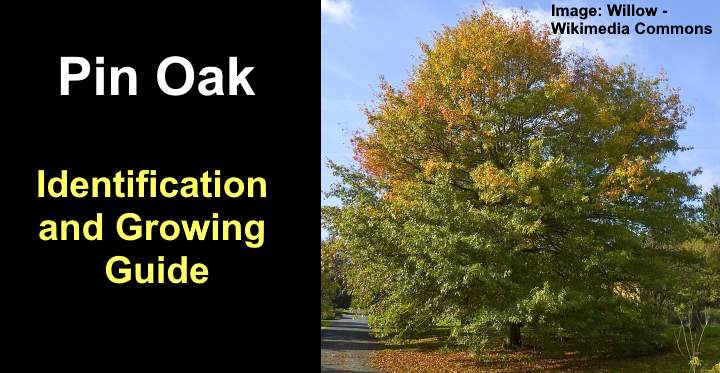
The pin oak tree (Quercus palustris) is a deciduous hardwood tree with bristle-tipped, deeply lobed green leaves, rounded dark brown acorns, and a dense, pyramidal crown that becomes rounded as the tree matures. Pin oak trees brighten up the fall landscape with their bright crimson red leaves that gradually turn coppery brown. In addition, pin oaks are identified by their distinctive branching in winter, which creates an attractive silhouette. Pin oaks are popular as street trees and shade trees in large residential parks or gardens.
This article is a comprehensive identification guide to the pin oak tree. Descriptions and pictures of pin oak leaves, acorns, bark, and flowers will help you recognize this majestic oak tree in the landscape. In addition, you will also get handy tips on growing a pin oak in your garden.
Facts About Pin Oak Tree
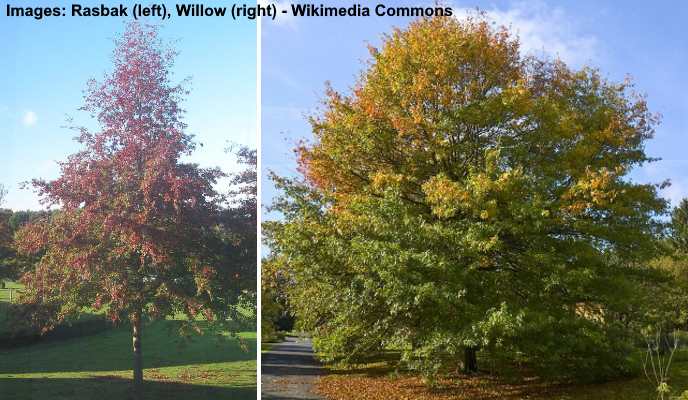
Young and mature pin oak trees (Quercus palustris)
The pin oak tree (Quercus palustris) is a fast-growing tree in the genus Quercus. Pin oaks belong to the group of red oak trees and are recognized by their pyramidal to oval crown. A feature of pin oaks is that their lower branches tend to droop, middle branches grow horizontally, and upper branches upward.
Pin oak grows between 60 and 70 ft. (18 – 21 m) tall and up to 46 ft. (14 m) wide. Pin oak trees have pointed, lobed leaves that measure on average 5” (13 cm) long and 4” (10 cm) wide. In the fall, pin oak acorns are mature and ready for harvesting. They are rounded, barrel-shaped nuts and measure up to 0.5” (13 mm) wide.
A distinctive feature of young pin oak trees is that their deciduous leaves remain on the branches throughout winter. This makes the oak tree an attractive winter landscape tree with its drooping bronze or russet-red foliage, creating plenty of colors when other trees have lost their leaves.
Pin oaks are suitable for growing in USDA zones 4 through 8. Like all types of oak trees, pin oaks thrive in full sun and perform best when grown in moist, well-drained soil. The hardy oak tree tolerates drought, heat, pollution, and soil compaction. However, it doesn’t tolerate poorly-drained soils.
A pin oak tree has a fast growth habit and can grow around 24” (60 cm) per year in ideal conditions. Its shallow, fibrous root system means the pin oak can withstand wet soils and soil compaction and even tolerate flood conditions.
Other names for Quercus palustris are the swamp Spanish oak, water oak, and swamp oak. The common name pin oak comes from the tree’s growth habit where lower branches break off, leaving pin-like stubs on the grayish-brown trunk.
The most common uses for pin oaks in a landscape are specimen trees or shade trees. The tree’s dense foliage and spreading crown are ideal for providing shade on hot summer days. According to some sources, pin oaks are one of the most common oak trees used in landscaping.
Related reading: Types of Florida oak trees.
What is Northern Pin Oak (Quercus ellipsoidalis)
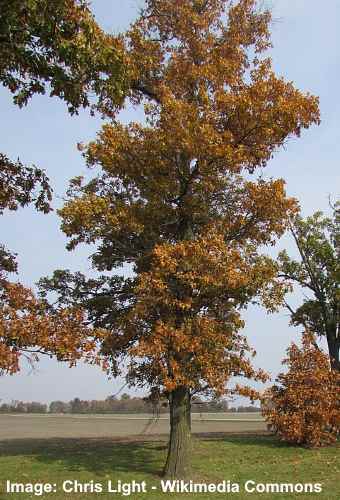
Northern pin oak (Quercus ellipsoidalis)
The northern pin oak is an ornamental tree related to the common pin oak. This oak tree species has a cylindrical shape and rounded crown and grows 50 to 70 ft. (15 – 21 m) tall and up to 60 ft. (18 m) wide.
It isn’t easy to distinguish northern pin oaks from regular pin oaks by their leaves. The leaves of both species are of similar size and shape. However, northern pin oak acorns are a rounded, pyramidal shape rather than the globus appearance of pin oak acorns. In addition, northern pin oak acorns mature pale brown and have darker vertical stripes.
Pin Oak Tree Leaves

Pin oak tree leaves
Pin oak trees are identified by their leaves with five to seven deep lobes with U-shaped sinuses and pointed tips with several bristles. The pin oak leaves are 2” to 6” (5 – 15 cm) long and 2” – 5” (5 – 13 cm) wide. Each leathery pin oak leaf has a smooth feel, apart from a hairy tuft down on the underside.
Pin oaks have an eye-catching fall color when the dark green leaves turn shades of red, including crimson, scarlet, and russet-red. An unusual identifying feature of pin oak foliage is that immature trees keep their deep reddish-brown leaves until spring. They then drop when new spring leaves emerge.
Related reading: Types of evergreen oak trees.
Pin Oak Tree Bark
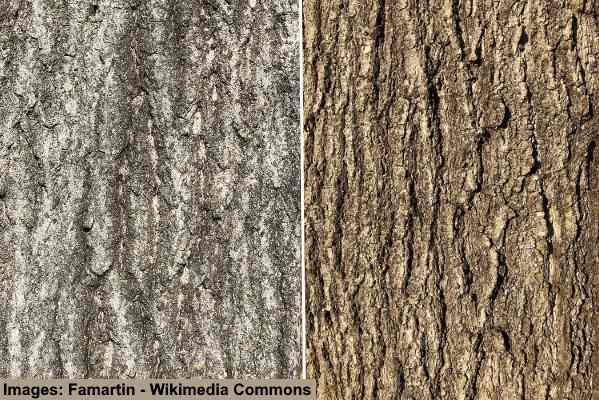
Bark of mature pin oak trees
Pin oak bark is reddish to gray-brown on immature trees. The bark on the straight, erect trunk is relatively smooth. As the pin oak matures, shallow fissures develop, creating a distinctive diamond pattern running longitudinally on the tree trunk. Sometimes, a reddish-brown color appears in the crevices.
Pin Oak Tree Flowers
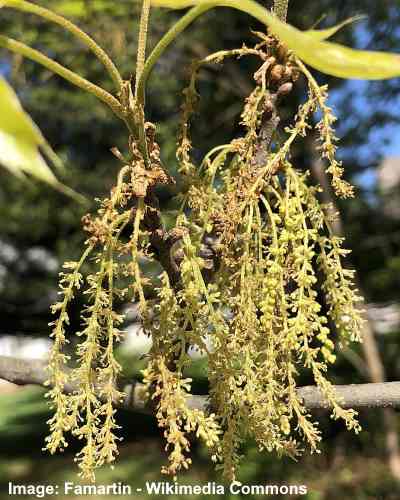
Pin oak flowers
Pin oak trees produce monoecious (male and female) flowers on the same tree. The insignificant yellowish-green flowers are dangling flowering stems. The pin oak male flowers are the long clusters of small blooms called catkins. The female oak flowers have a reddish tinge, and they grow on short spikes.
Pin Oak Tree Acorns
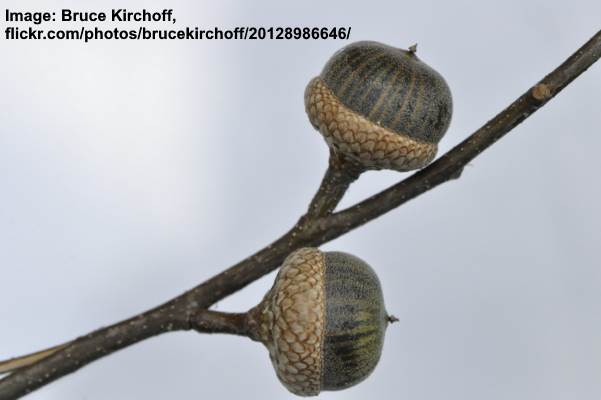
Pin oak acorns
Pin oak trees are identified by their globular dark brown acorns with a reasonably flat top. The rounded, barrel-shaped nuts sit in a shallow, thin, light-brown bumpy cap. The scaly cap covers less than one-third of the acorn, and there is a pointed apex on the rounded top.
Pin oak acorns measure 0.4” to 0.6” (10 to 16 mm) long and 0.35” to 0.6” (9 – 15 mm) in diameter. Like most species of red oaks, pin oak acorns mature in two seasons. It takes between 15 and 20 years before a pin oak produces acorns.
Are pin oak acorns edible? You can eat acorns from a pin oak after leeching the tannins to remove the bitter taste. However, the nuts aren’t as sweet as acorns from species of white oak trees, some of which can be consumed straight off the tree.
Pin Oak Tree Identification
A pin oak tree is identified by its growth habit, leathery, dark-green, deeply lobed leaves with bristled tips, and dark brown globular acorns in a scaly tan cap. A distinctive feature of a pin oak is its unique branching pattern — lower branches point downward, middle branches are horizontal, and upper branches are ascending.
Where to Plant Pin Oak Tree
Pin oaks are ideal landscaping trees in USDA zones 4 through 8 because they adapt easily to urban conditions and clay soils. They also transplant well if you need to change their location. A pin oak grows in loamy, acidic, well-drained, fertile and damp soils.
The best location for planting a pin oak tree is in full sun where it can grow in neutral to acidic soil. The planting site should be well-draining but hold enough moisture to keep the tree’s roots relatively moist. As the pin oak becomes established, watering is rarely an issue.
Another consideration when planting a pin oak tree is its height and width. All oaks — including the pin oak — grow relatively large. Therefore, plant a pin oak at least 20 to 30 ft. (6 – 10 m) away from any structure. This helps ensure that the strong roots don’t damage the foundation. Also keep them away from power lines.
How to Plant Pin Oak Tree
The easiest way to grow a pin oak in your garden landscape is to purchase a quality specimen from a reputable nursery.
To plant a pin oak tree, dig a hole twice the width and depth of the root ball. Then combine a good amount of compost with the native soil. Next remove any covering from the young tree’s roots and place in the hole. Backfill the hole, ensure that the tree grows at the same depth as in the nursery container.
As you fill the hole with the amended soil, press down as you go. This is vital to support the tree and remove any air pocket from the planting site.
Once the pin oak is in the ground and relatively secure, thoroughly soak the soil to deeply water the tree. This removes the last pockets or air and hydrates the roots. The last step is to add a 2” to 3” (5 – 7.5 cm) layer of organic mulch to lock in moisture and prevent weeds from growing.
To help establish the pin oak in your garden, water the tree once a week by giving it a deep watering for the first year. The best way to water an immature pin oak is to water the root area slowly, ensuring that water penetrates the soil down to the roots.
Pin Oak Tree Propagation (How to Grow an Oak Tree From Acorns)
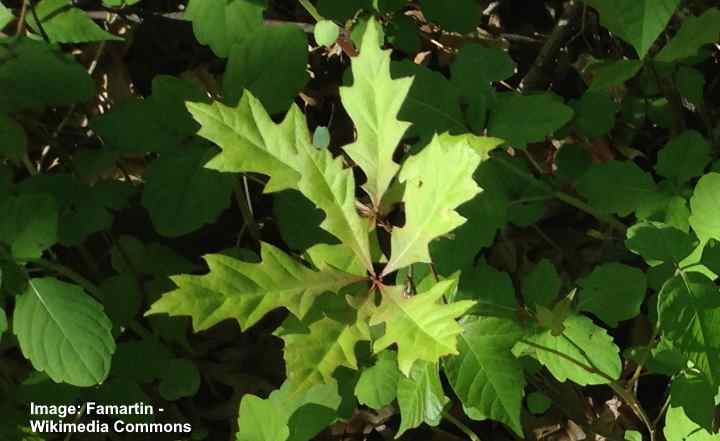
Pin oak sapling
Growing a pin oak tree from acorns can be an exciting project. Successful planting requires harvesting the best pin oak acorns and preparing them for germination. Pin oak acorns need stratification — exposure to cold temperatures — to spout into seedlings.
To ensure that an acorn germinates, pick mature acorns directly from the tree, not the ground. Remember that acorns from red oaks take two years to mature. Once you’ve harvested acorns, remove the caps, and check for holes. Then drop them in a bucket of water and discard any that float or have holes.
To prepare pin oak acorns for germination, put them in a mixture of equal parts of moist sand and vermiculite. Half-fill a food bag with the mixture and put the acorns in the middle. Then put the sealed bag in the refrigerator for 30 to 45 days.
You can then transfer the acorns to small individual pots containing a mixture of peat-free compost. Plant the nuts about 1” (2.5 cm) deep in the soil. Keep the potting medium moist, but never soggy. When the pin oak seedling is at least 8” (20 cm) tall, you can plant it in the garden.
Alternatively, you can plant acorns directly in the ground in the fall where the winter temperatures will stratify the seeds.
Pin Oak Tree (Quercus palustris) Care Guide
Growing a pin oak tree is relatively straightforward. Pin oaks thrive in full and almost any type of well-drained soil. During dry spells, occasional watering is necessary. However, established pin oaks generally get by without much care. The worst conditions for a pin oak are alkaline soil and poorly draining ground.
Let’s look in more detail at how to ensure a pin oak thrives in your landscape and stays free of pests and diseases.
How to Water Pin Oak Tree
Once a pin oak is established in the landscape, it requires very little additional watering. The only time you need to irrigate the root area is during particularly arid periods. However, pin oaks are relatively tolerant of drought and can go for many weeks without watering.
It is crucial to water an immature pin oak regularly. Typically, you should water the newly-planted tree weekly for the first year. However, if there has been a lot of rainfall, you can water the tree less frequently. In addition, you can water it less often in winter.
The pin oak also goes by the names water oak and swamp oak. This is because the oak tree has an especially high tolerance for wet ground. In its native environment, it often grows beside streams and can tolerate growing in standing water for several weeks.
Pin Oak Tree Fertilization
Fertilizing a pin oak tree is only necessary in early spring. However, a pin oak older than ten years old generally doesn’t need to be fertilized unless there is a nutrient deficiency. However, you can add rotten manure or compost and a thick layer of organic mulch around the root area every spring to keep the tree healthy.
If you decide to fertilize a young oak tree, you can either add compost in spring and summer or use a tree fertilizer. The best type of fertilizer for an oak tree is one with an NPK ratio of 12-6-6 or 12-4-8. A slow release of nitrogen will help the tree produce lush, leafy foliage throughout the growing season.
How to Prune Pin Oak Tree
It’s best to prune a pin oak tree in the dormant state — from November through February. To prune the tree, remove dead or broken branches during the first three seasons. It’s also vital to remove any limbs that could compete with the main branch. After the third year, you can prune a pin oak every few years.
When pruning an established pin oak, you should remove branches that grow too close to one another, rub together, or inward toward the tree. It is also a good idea to remove branches growing two thirds up the tree. This helps ensure suitable clearance under a mature tree.
Use shears to trim thin branches, branch loppers for limbs up to 1.5” (38 cm), and a curved pruning saw for larger limbs. To prune branches over 6 ft. (1.8 m) from the ground, use a pole pruner.
Pests Affecting Pin Oak Tree Growth
Several types of pests can affect a pin oak tree’s growth. However, insects, bugs, and mites rarely do any serious damage to healthy trees. Common pests affecting pin oaks include aphids, scale insects, caterpillars, and leaf miners. Acorn weevils burrow into acorns and consume them for the nutty flesh.
Aphids bite into soft leaf tissue and can cause pin oak leaves to become distorted. However, aphid activity is rarely a serious issue for a pin oak.
Caterpillars and tent worms can destroy foliage on healthy pin oak trees. Usually, caterpillar activity only affects the oak tree’s aesthetics, not its overall health. If you notice tent caterpillars, you should remove the nest while they are small.
Oakleaf miners can cause leaves to turn brown.
Acorn weevils are small brown beetles that burrow into acorns and eat them hollow. Beetle activity is the primary reason some acorns don’t germinate.
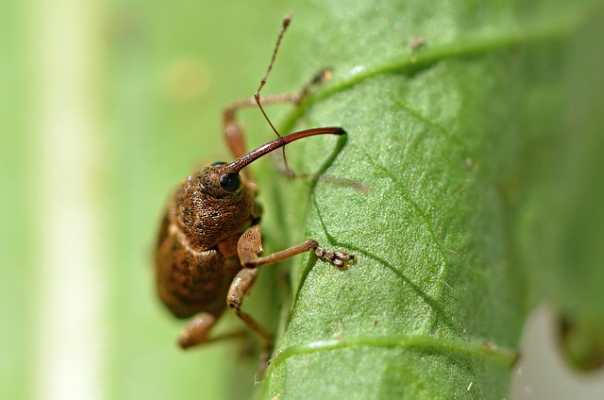
Acorn weevil
Pin oak galls are irregular brown growths on an oak tree’s leaves and limbs. They result from insects and mites that lay eggs, and when the larvae start feeding on plant tissue, the tree reacts by producing unsightly round growths.
Diseases Affecting Pin Oak Tree Growth
Pin oaks are susceptible to several fungal and bacterial diseases, some of which can severely affect the tree’s health.
Oak wilt (Ceratocystis fagacearum) is a common problem for red oaks and pin oak trees. The fungal pathogen is spread when beetles bore into tree roots, transmitting the disease. Signs of oak wilt are leaves that become yellow and brown and drop suddenly. If you suspect oak wilt, it vital to call professional arborists as soon as possible
Powdery mildew causes a waxy white growth and sometimes black dots on oak leaves. The pin oak leaves will look wrinkled, deformed, and drop before it’s the fall. The unsightly leaves are usually due to lack of air circulation or cool, damp conditions. Powdery mildew can cause a white powder-like substance to appear on leaf surfaces. Check out some tips to treat powdery mildew on oaks.
Iron chlorosis is the most common disease to affect pin oaks. A lack of iron in the soil causes leaves to develop a deep yellow color and the leaf veins may also turn yellow or white. Reversing a soil iron deficiency can be challenging and costly and usually require professional advice.
Related articles:
